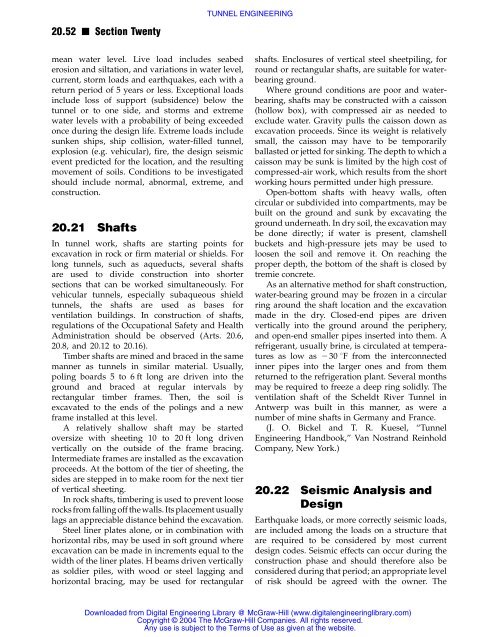TUNNEL ENGINEERING
TUNNEL ENGINEERING
TUNNEL ENGINEERING
Create successful ePaper yourself
Turn your PDF publications into a flip-book with our unique Google optimized e-Paper software.
20.52 n Section Twenty<br />
mean water level. Live load includes seabed<br />
erosion and siltation, and variations in water level,<br />
current, storm loads and earthquakes, each with a<br />
return period of 5 years or less. Exceptional loads<br />
include loss of support (subsidence) below the<br />
tunnel or to one side, and storms and extreme<br />
water levels with a probability of being exceeded<br />
once during the design life. Extreme loads include<br />
sunken ships, ship collision, water-filled tunnel,<br />
explosion (e.g. vehicular), fire, the design seismic<br />
event predicted for the location, and the resulting<br />
movement of soils. Conditions to be investigated<br />
should include normal, abnormal, extreme, and<br />
construction.<br />
20.21 Shafts<br />
In tunnel work, shafts are starting points for<br />
excavation in rock or firm material or shields. For<br />
long tunnels, such as aqueducts, several shafts<br />
are used to divide construction into shorter<br />
sections that can be worked simultaneously. For<br />
vehicular tunnels, especially subaqueous shield<br />
tunnels, the shafts are used as bases for<br />
ventilation buildings. In construction of shafts,<br />
regulations of the Occupational Safety and Health<br />
Administration should be observed (Arts. 20.6,<br />
20.8, and 20.12 to 20.16).<br />
Timber shafts are mined and braced in the same<br />
manner as tunnels in similar material. Usually,<br />
poling boards 5 to 6 ft long are driven into the<br />
ground and braced at regular intervals by<br />
rectangular timber frames. Then, the soil is<br />
excavated to the ends of the polings and a new<br />
frame installed at this level.<br />
A relatively shallow shaft may be started<br />
oversize with sheeting 10 to 20 ft long driven<br />
vertically on the outside of the frame bracing.<br />
Intermediate frames are installed as the excavation<br />
proceeds. At the bottom of the tier of sheeting, the<br />
sides are stepped in to make room for the next tier<br />
of vertical sheeting.<br />
In rock shafts, timbering is used to prevent loose<br />
rocks from falling off the walls. Its placement usually<br />
lags an appreciable distance behind the excavation.<br />
Steel liner plates alone, or in combination with<br />
horizontal ribs, may be used in soft ground where<br />
excavation can be made in increments equal to the<br />
width of the liner plates. H beams driven vertically<br />
as soldier piles, with wood or steel lagging and<br />
horizontal bracing, may be used for rectangular<br />
<strong>TUNNEL</strong> <strong>ENGINEERING</strong><br />
shafts. Enclosures of vertical steel sheetpiling, for<br />
round or rectangular shafts, are suitable for waterbearing<br />
ground.<br />
Where ground conditions are poor and waterbearing,<br />
shafts may be constructed with a caisson<br />
(hollow box), with compressed air as needed to<br />
exclude water. Gravity pulls the caisson down as<br />
excavation proceeds. Since its weight is relatively<br />
small, the caisson may have to be temporarily<br />
ballasted or jetted for sinking. The depth to which a<br />
caisson may be sunk is limited by the high cost of<br />
compressed-air work, which results from the short<br />
working hours permitted under high pressure.<br />
Open-bottom shafts with heavy walls, often<br />
circular or subdivided into compartments, may be<br />
built on the ground and sunk by excavating the<br />
ground underneath. In dry soil, the excavation may<br />
be done directly; if water is present, clamshell<br />
buckets and high-pressure jets may be used to<br />
loosen the soil and remove it. On reaching the<br />
proper depth, the bottom of the shaft is closed by<br />
tremie concrete.<br />
As an alternative method for shaft construction,<br />
water-bearing ground may be frozen in a circular<br />
ring around the shaft location and the excavation<br />
made in the dry. Closed-end pipes are driven<br />
vertically into the ground around the periphery,<br />
and open-end smaller pipes inserted into them. A<br />
refrigerant, usually brine, is circulated at temperatures<br />
as low as 230 8F from the interconnected<br />
inner pipes into the larger ones and from them<br />
returned to the refrigeration plant. Several months<br />
may be required to freeze a deep ring solidly. The<br />
ventilation shaft of the Scheldt River Tunnel in<br />
Antwerp was built in this manner, as were a<br />
number of mine shafts in Germany and France.<br />
(J. O. Bickel and T. R. Kuesel, “Tunnel<br />
Engineering Handbook,” Van Nostrand Reinhold<br />
Company, New York.)<br />
20.22 Seismic Analysis and<br />
Design<br />
Earthquake loads, or more correctly seismic loads,<br />
are included among the loads on a structure that<br />
are required to be considered by most current<br />
design codes. Seismic effects can occur during the<br />
construction phase and should therefore also be<br />
considered during that period; an appropriate level<br />
of risk should be agreed with the owner. The<br />
Downloaded from Digital Engineering Library @ McGraw-Hill (www.digitalengineeringlibrary.com)<br />
Copyright © 2004 The McGraw-Hill Companies. All rights reserved.<br />
Any use is subject to the Terms of Use as given at the website.
















